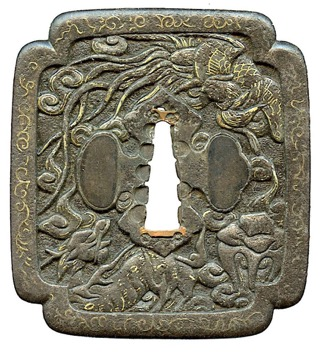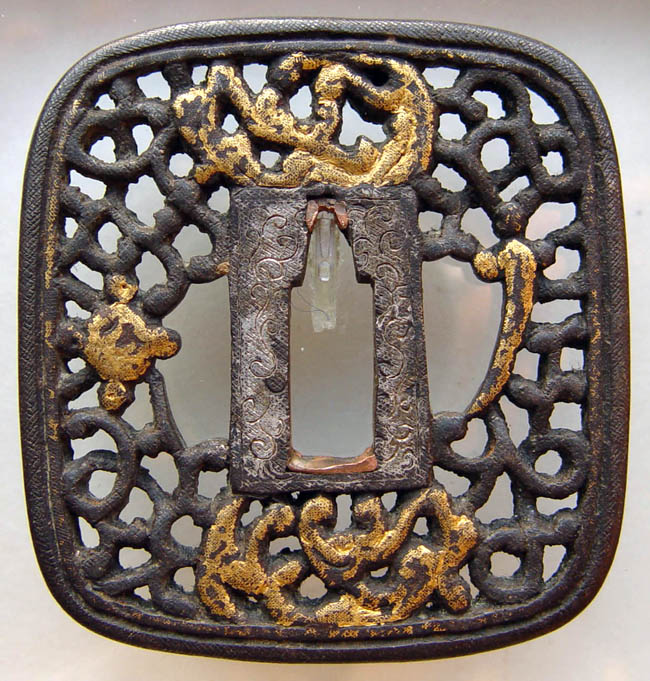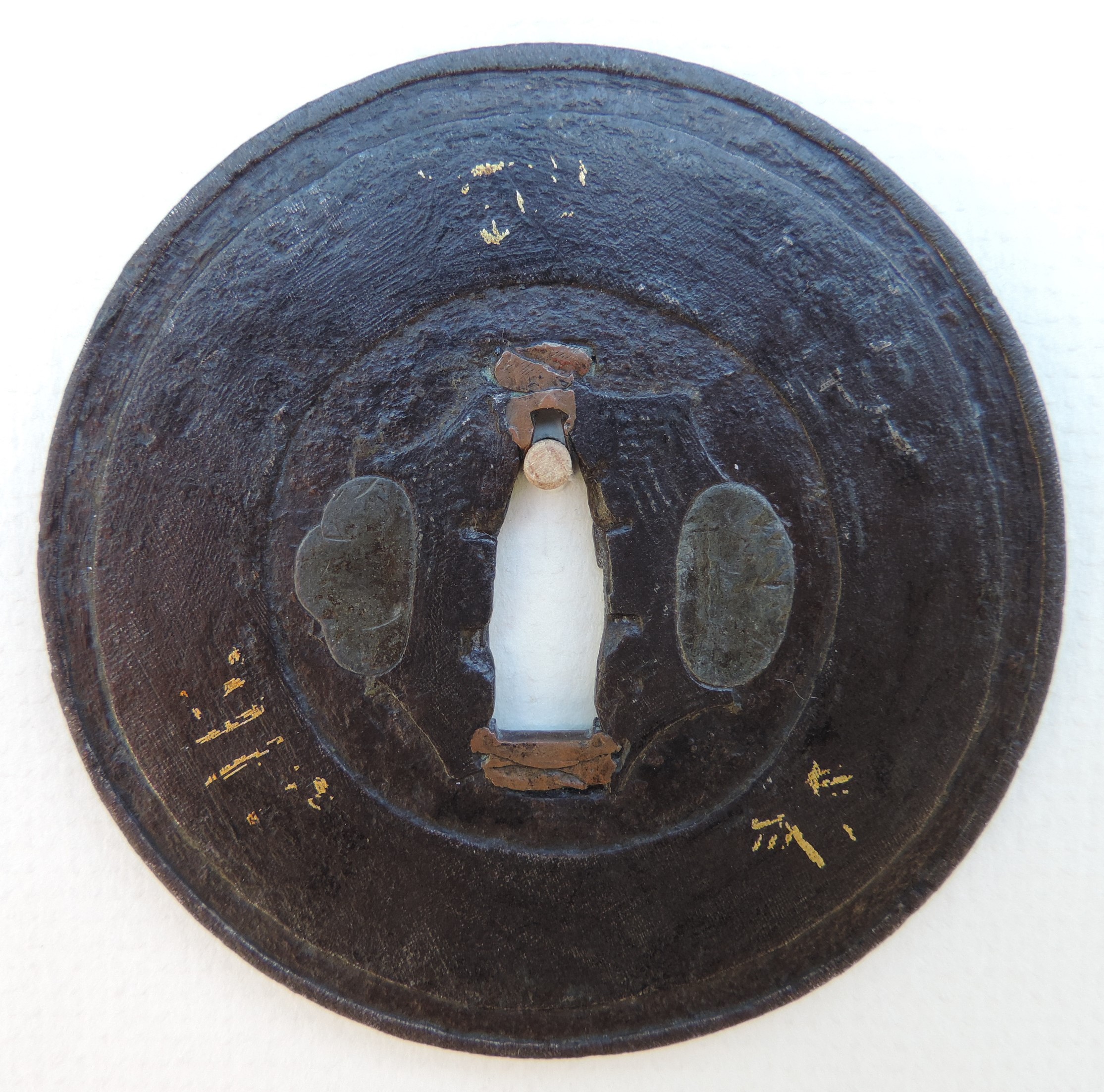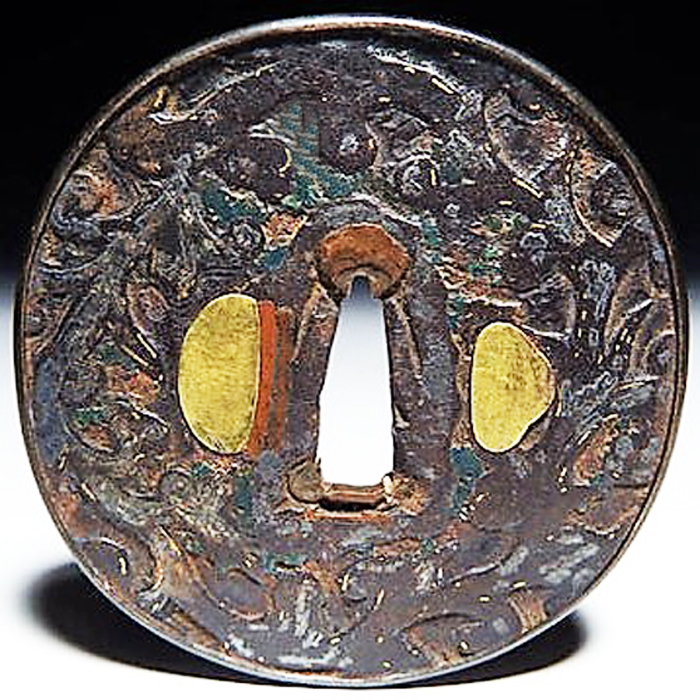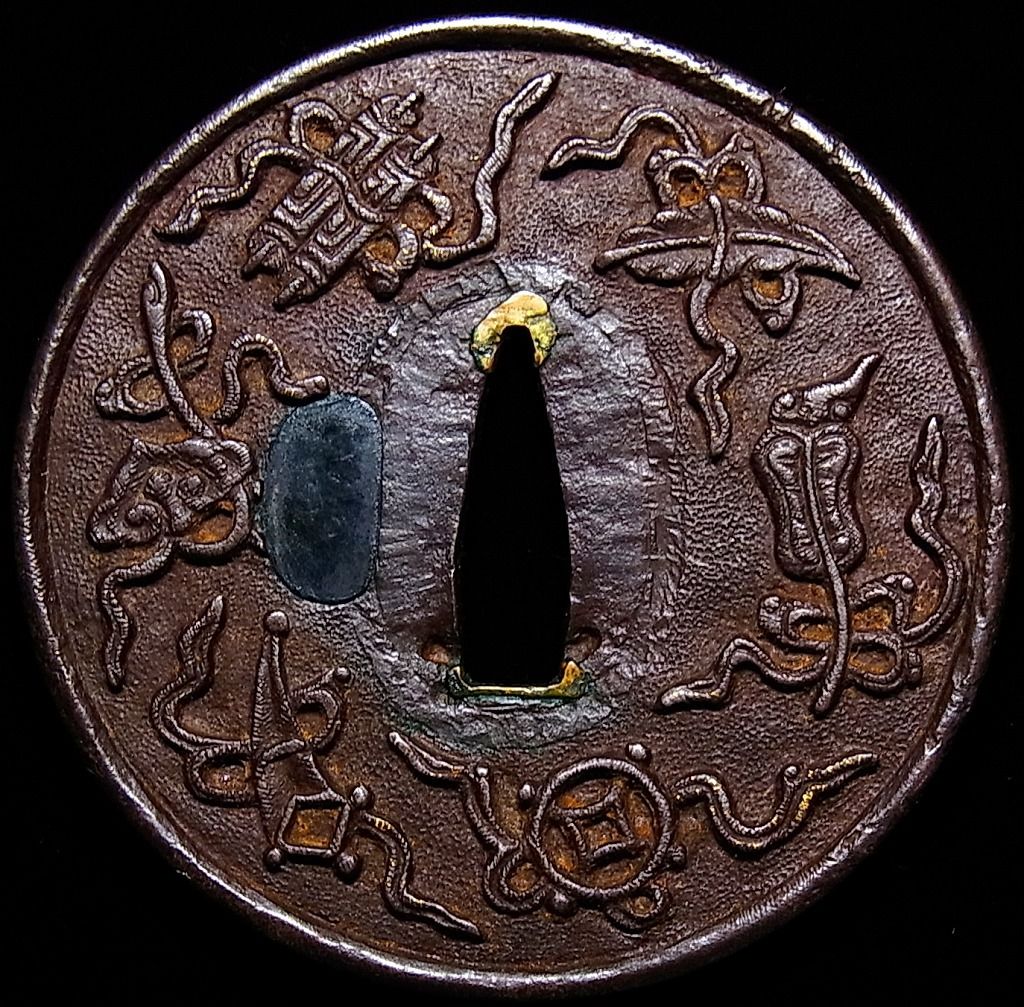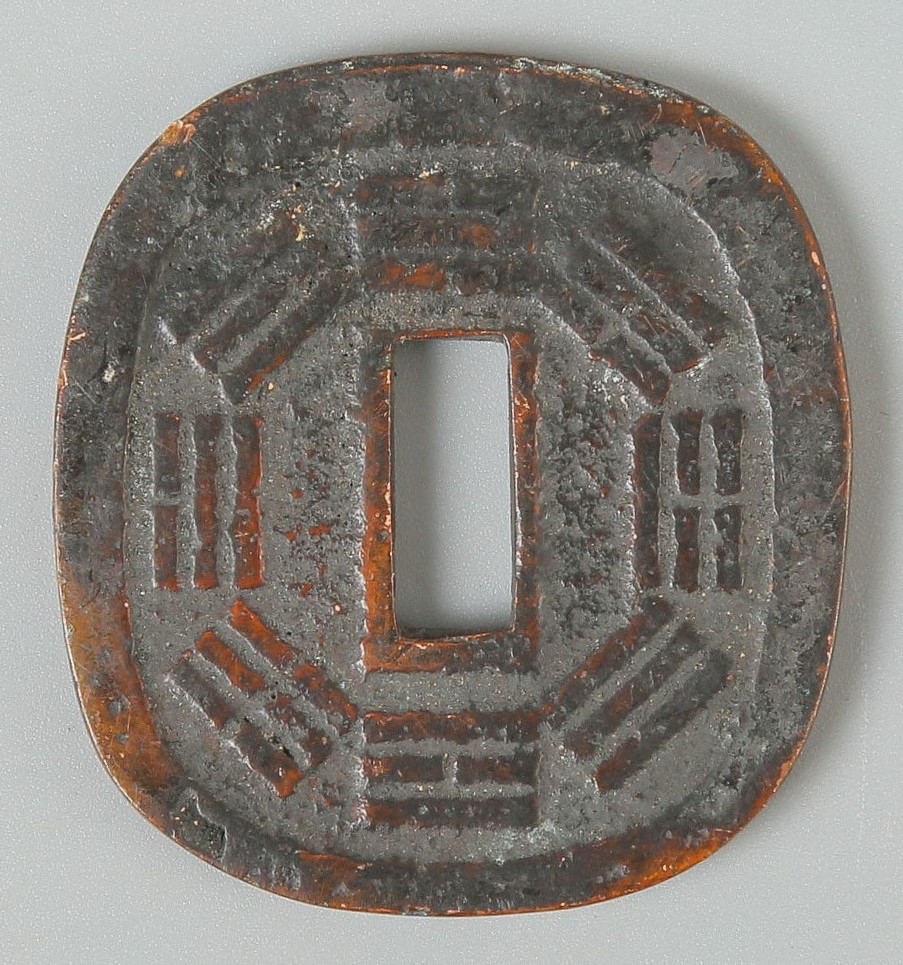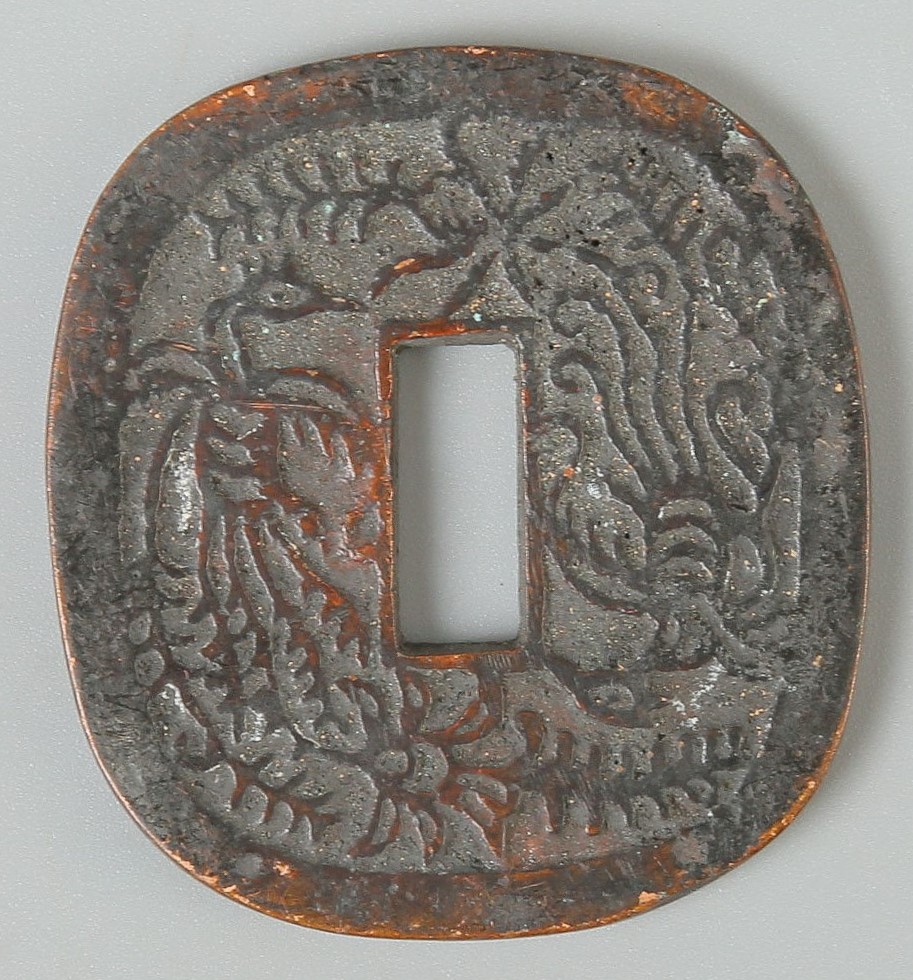KIYOU-TOJIN $1800.00
"Large rectangular sword guard. Iron with gold wire inlay. The manner of execution represents a high degree of artistic hybridity, suggesting that this piece was made along maritime trade- routes, where artisans had access to decorative arts from around the globe. The indented corners, pointed Shitogi-gata seppa-dai, smooth- skinned dragons and almost caricature drawing- style points to Indochina, perhaps Tonkin. In his book Nanban Tsuba, Yoshimura Shigeta illustrates a similar piece on page 10. The caption reads,
“Nagasaki-he gairai-shita Chukokujin no saku…” (Made by a Chinese person who came into Nagasaki)." (J. McElhinney)
8.15cm x 7.50cm x 0.40cm
KIYOU TOJIN
$800.00
"A Chinese guard, possibly made in Nagasaki by Chinese carvers for the Chinese market, or for the Dutch gift and Japanese Rangaku-Omiyage market. The rectangular shape of seppa-dai confirms early to middle Qing in Sino-Tibetan style for use with Chinese tang. This dates to ca. 1750. At a later date, the Higo-style punch marks could have been done in Higo when adapted to Japanese use." (E. Long)
6.90cm x 7.65cm x 0.45cm
CHINESE / HIZEN
$6000.00
"A well-hammered iron plate with a dark chocolate patina and decorated with a pair of phoenixes. The very thin plate and rich patina suggest considerable age. Made in China during the Ming period, ca 1600 or earlier. Upon arriving in Hizen, adapted to Japanese use.
On the omote face are very artistic representations of two fenghuang (phoenix). One of the twelve signs of the Chinese zodiac, the phoenix is a Chinese symbol of honesty, as well as physical and moral fortitude. From the Jiaqing era (1522–66) of the Qing dynasty onwards, a pair of phoenixes was differentiated by the tail feathers of the two birds, typically together forming a closed circle pattern—the male identified by an ood number of long serrated tail feathers (odd number being a masculine, or yang number) and the female by what appears to be an even number curling or tendrilled tail feathers (even number being feminine, or yin number).
On the ura appears six seal script figures, an archaic form of Chinese. Usually these inscriptions are prayers or axioms of some kind." (E. Long)
9.40cm x 9.30cm x 0.25cm
INDOCHINESE PIXIU
$2000.00
"Round iron plate with very fine silver nunome zogan of two PiXiu - a mythological Indochinese creature. In Indochina (Thailand, Laos, Cambodia and Vietnam) they have leonine heads with long forelocks. These represent the great Naga King of the Eastern Sea, master of storms and all things marine. On the reverse are various Indochinese symbols all done in very fine silver inlay. The entire motif is not Japanese, but based on the nakago-ana, hitsu-ana and pipe-like circular (chukushiki dote mimi) rim, this was produced in Hizen.
Accompanied with NBTHK Hozon Certificate dated Nov. 23rd, 1962." (E. Long)
7.85cm x 8.0cm x 0.65cm (rim), 0.35cm (seppa)
CHINESE (ASIAN EXPORT)
SOLD - Reference Only
"Design motif of two herons is from ceramic origin. The top and bottom symbols are perhaps very stylized 'tama' jewels or lotus buds. The seppa-dai is of a shape that is neither Chinese or Japanese. Silver nunome on the edge of the seppa-dai, very faint. The hitsu is a later addition upon its arrival in Japan. Momoyama age, ca.1600." (E. Long)
7.60cm x 7.65cm x 0.55cm

KANTON $1300.00
7.10cm x 7.00cm x 0.4cm
Chinese QING Style Guard $700.00
"A Qianlong style iron guard, finely carved in openwork, with traces of gold false damascening. The floral/foliate decoration is inspired by Tibetan and Central Asian saddle plates or Monsoon Asian textiles. This is clearly not Japanese. The mythological creature on the right side with its pointed forelock is reminiscent of the Mekong Phayanak. The other three creatures appear to have wings and tail feathers.
The condition of this guard is excellent and shows that it was adapted to Japanese use. The highlights of gold inlay on the crosshatched areas is very well done.
An exceptional handguard of great quality." (E. Long)
7.50cm x 7.80cm x 0.50cm
QING Guard Reference Only
"Qing guard employing design tropes found on Qing imperial dragon-robes. The web is a tangled openwork of interlacing tendrils that represent moving water. The topic of the design is the carp becoming a dragon by leaping over the dragon gate on the Yellow River in China, signifying accomplishment.
The gold inlay is intact and in finely worked nunome zogan. The rim is rounded (maru mimi). The hitsu-ana and sekigane were added when adapted to Japanese use." (E. Long)
7.65cm x 7.75cm x 0.70cm
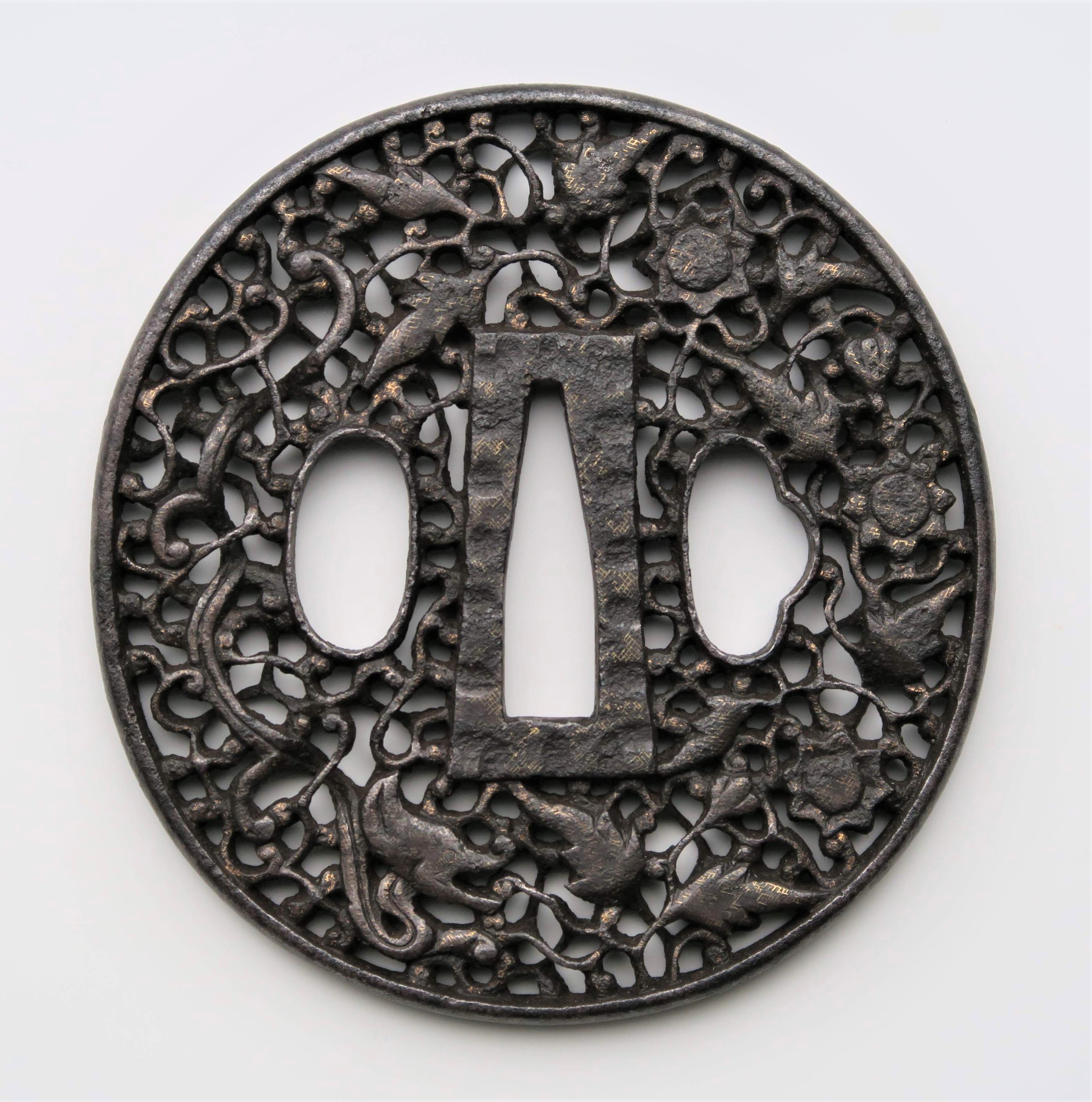
QING Dynasty $1400.00
7.50cm x 7.80cm x 0.50cm

CHINESE-QING $2000.00
The seppa-dai identifies the area of manufacturer.
The inner rim has design of a key or fret pattern.
The shape of the seppa-dai reminds one of an hour glass. Compare with the shape of Hosodachi guards, so-called shitogi-gata, from the Heian period. Obviously it copies a mainland (Sino-Korean) prototype that predated the development of the common discord guard we see today.
The condition of this guard is excellent and shows that it was adapted to Japanese use.
7.50cm x 7.80cm x 0.50cm
SINO-TIBETAN QING (ASIAN EXPORT)
$700.00
"Imported Sino-Tibetan style Qing tsuba of iron with gold highlights. Incredible complex design of dragon-koi's or 'chilong' swimming in turbulent water, rendered as loukong interlacing. The dragon-koi represents the excercise of positive force. Legend has it that when the koi swimming upstream overcomes a waterfall, it becomes a dragon. These creatures are rendered at the moment of transformation, an inspiration to those after some kind of loss, or in a period of transition. The surface decoration of lotus blossom, flaming jewel on top and pagoda on the bottom are for visual appeal.
The rectangular shape of the seppa-dai is to be expected on Qing guards. The carving crosses over and under and the kogai & kozuka hitsu-ana are original to the piece. The rim is gilt beading and majority of the gold remains." (E. Long)
6.6cm x 7.0cm x 0.35cm
CHINESE Sword Guard $750.00
"Rounded square iron guard with very thick and heavy rim. The shape might allow us to date it to early Qing period (1644-1700) during which this shape was popular. The design consists of paired chilong (water dragon) in openwork tendrils at top and bottom, and two peculiar features located at both sides. The two features could represent ritual objects used in tantric Buddhism. Just under the thick rim appears gold inlay on a variation of the double rim found on some early imperial Qing saber guards. The copper sekagane confirms being adjusted for Japanese use." (E. Long)
6.6cm x 7.0cm x 0.5cm
CHINESE CAST GUARD Reference Only
"A cast iron guard of Chinese origin. The broken areas and missing bat head indicate the iron being very brittle. The casting line can still be seen on the inside confirming it’s made of cast iron. The rendition of the bats is rather Chinese in form, in a way you also see them on porcelain of the 18th and 19th centuries. The bat is a symbol for luck in Chinese, both being pronounced “fu” in standard Mandarin. The fact that it’s cast is quite unusual. Generally, in China as in Japan, guards tend to be forged." (E. Long)
6.85cm x 7.20cm x 0.55cm
INDOCHINESE
$500.00
"There are two indications that point to Indochinese origins for this guard. The first are the serpentine dragons, similar to Mekong Phayanak, or protector river-serpent. The second are the lotus flower buds at the top and bottom of the design. The "Loukong" interlacing shows loyalty to the taste of the Qianlong court. Unlike many Chinese guards, it is formed not by carving but by drilling holes through the plate, heating the metal and bending it. The interpretation of the mythical beasts is almost childish, having a folk-art feeling, unlike the kind of obsessive workmanship one finds in Japanese "Kanton" guards. The hitsu-ana are impractical, added to give the piece a Japanese flavor." (E. Long)
7.10cm x 7.00cm x 0.40cm

VIETNAMESE or HEIANJO $2000.00
Satsuma traded with the nearby counties via the Ryukyus. Hirado continued to trade with Joseon. There was a large nihonmachi at Hoi An, Vietnam, and others scattered across Monsoon Asia. After 1684 Chinese merchants flooded Nagasaki. Within a few decades the Toujin-Yashiki (chinatown) was home to 10% of the population.
This guard could very well be Vietnamese. Please note the photo by Peter Dekker of Tromp's Weapons Rack at the Rijksmuseum. Those Japanese-style swords were produced in Tonkin ca. 1660-1680.
8.22cm x 8.22cm x 0.48cm
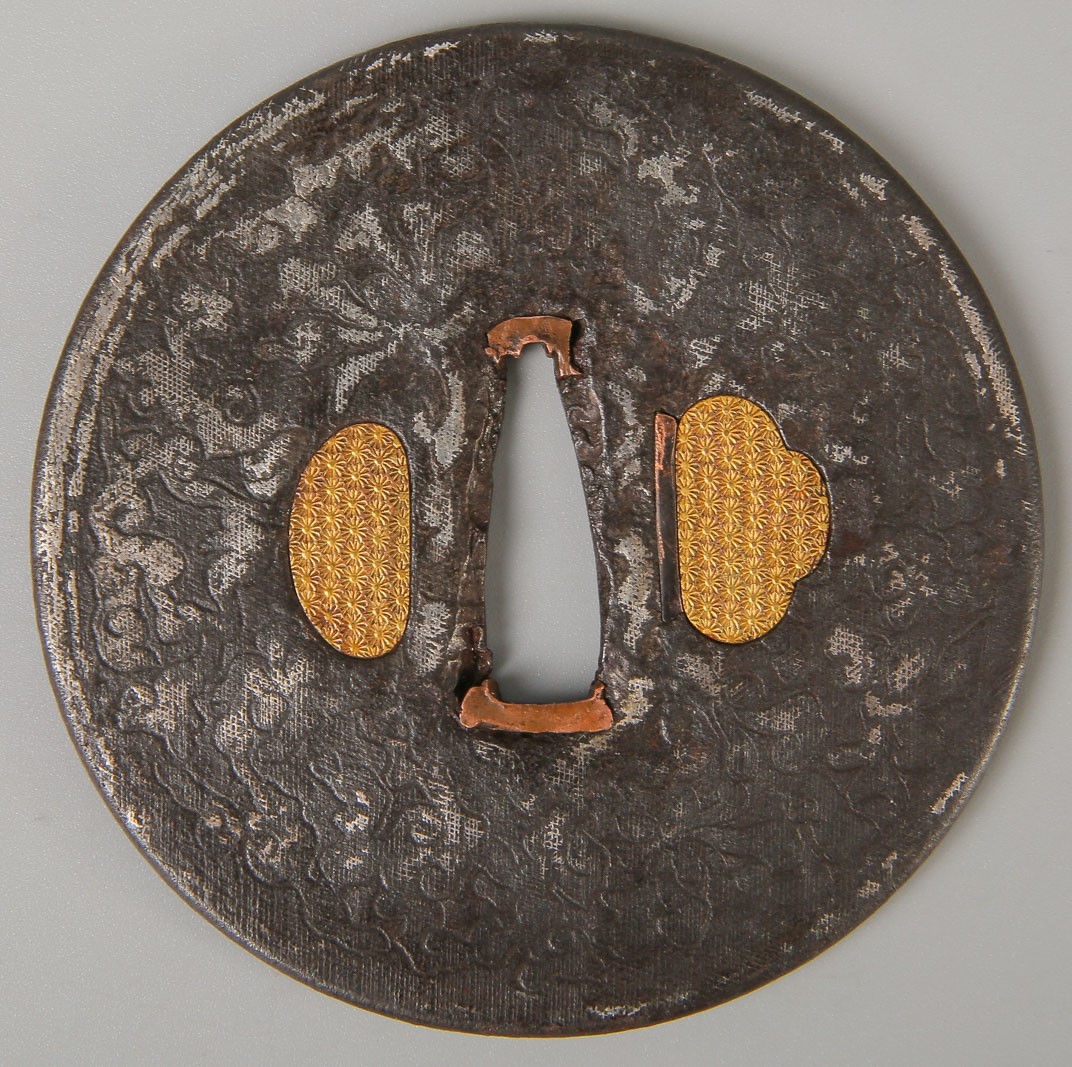
VIETNAMESE $700.00
7.95cm x 8.00cm x 0.35cm
MONSOON-ASIAN Sword Guard
$800.00
"Iron sword guard with traces of gold and silver inlay of symbols and Chinese characters. Unusual pointed, octagonal seppa-dai. Lead-filled hitsu-ana are a later addition, not integral to the design. The thin plate has a rich patina suggesting significant age, late Muromachi period. This seems to be the work of a Monsoon Asian metalworker adapting Japanese design to local weapons production. This is a very interesting piece for several reasons. The shape is almost perfectly round. The excavated areas are not finished with the same care as the inlayed surfaces have been. Cross-hatching covers the pointed octagonal seppa-dai and dominant ring of designs around it. It is possible that the lower areas were carved out roughly to accommodate possibly enameling, which is now lost, along with much of the inlay." (E. Long)
8.79cm x 8.74cm x 0.35cm
MONSOON-ASIAN Sword Guard
Study Piece
"Minor traces of a Celadon shade of green lacquer appears in negative spaces. This technique, which filled the negative spaces carved out of the plate, is known as 'champleve' (lifted field). Basically, fusing the color to the base metal with heat. This guard is clearly not of Japanese origin, but has been adapted to Japanese use, the hitsu-ana and shakudo fukurin were later additions. Vestiges of gold and silver inlay appear both sides.
Iron is an inferior substrate for enameling. Hirata Donin is said to have learned enameling from Koreans, some say in Hirado. Hirado also traded with Korea well into the Edo period." (E. Long)
7.80cm x 7.30cm x 0.40cm
SOUTH-ASIAN Sword Guard
$900.00
"Champleve sword-guard of iron originating in Southern Asia.
The technique of filling negative spaces carved into the solid plate, is known as "champleve". It seems that the negative spaces were never filled with colored vitreous enamel. The level figures left after carving the recesses are representations of seal script, an archaic form of Chinese. Usually these inscriptions are prayers or axioms of some kind. These have very fine inlay of gold. The opposite face is completely blank and smooth.
This guard is not of Japanese origin but was later adapted to Japanese use. The original tang-aperture is too wide for a sword tang, and with the washer-seat being almost round, indicating that it was probably first mounted on a polearm. When it was fitted with sekigane, the hitsu-ana were added. And later yet the hitsu-ana were filled with shakudo plugs." (E. Long)
8.00cm x 8.00cm x 0.35cm
MING Sword Guard SOLD
"Iron Asian Export-style sword-guard. Dote-mimi, with Taoist symbols executed in taka-bori on ishime-ji. The ura is identical to the omote. Almost circular form, raised rim and distribution of designs is reminiscent of Chinese mirrors. The presence of Taoist symbols alone should lead one to question the assumption that this piece might be Japanese. The elliptical formation of the seppa-dai might lead one to believe this is Japanese, but one must bear in mind that other countries, notably Vietnam, produced sword handles with oval cross-sections. In all likelihood this guard was produced in China, or one of these foreign enclaves. Seems to date to early pre-1640. The piece was awarded a Tokubetsu Kicho paper by the NBTHK in 1974, with an attribution as Nanban." (E. Long)
7.99cm x 7.98cm x 0.56cm
SOUTHERN CHINESE
Understudy
"A small copper sword guard with Daoist symbols on both sides.
On one side are representations of the 'Eight Trigrams' of the I-ching, known in China as 'bagua'. This is one of the oldest classical texts, believed to have been written in the Western Zhou of the 8th to 10th century B.C. The trigrams symbolize eight changing states in the world through Yin and Yang.
On the other side are very artistic representations of two Roosters (fenghuang). One of the twelve signs of the Chinese zodiac, the Rooster (or Phoenix) is a Chinese symbol of honesty, as well as physical and moral fortitude. From the Jiaqing era (1522–66) of the Qing dynasty onwards, a pair of phoenixes was differentiated by the tail feathers of the two birds, typically together forming a closed circle pattern—the male identified by five long serrated tail feathers or "filaments" (five being an odd, masculine, or yang number) and the female by what sometimes appears to be one but is in fact usually two (an even number) curling or tendrilled tail feathers (even number being feminine, or yin number)." (E. Long)
4.60cm x 5.00cm x 0.30cm
HIRADO
$2400.00
"Originally cast by Chinese mirror makers possibly dating to the Muromachi period, 1336-1573. Chinese design of two dragons chasing the flaming jewel on the face and the representation of the five mountains of China with two representations of animals. Traveled from China by way of Korea to Hirado being a trading port for Korean goods. After arriving in Hirado, the tang aperture was modified to fit a Japanese katana and the hitsu ana with pillows were added." (E. Long)
7.90cm x 7.60cm x 0.50cm
'HIRADO ju KUNISHIGE'
Understudy
"Subject of dragons chasing jewels (tama) in waves and clouds. Copper (Suaka) Usuniku-bori (sunken relief) with Katakiri-bor (direct line engraving). The rim is decorated in katakir-bori in a Greek key-pattern. Signed "Hirado no ju Kunishige" (H 03650.0). Many small tsuba of this kind were produced on the island of Hirado as shiiremono (ready-made goods) used as business gifts or status symbols. Japanese physicians are said to have worn Nanban tsuba as a way of proclaiming their possession of Rangaku (Hollander learning); Western science and medicine. There appears to be more than one generation signing "Kunishige". The shodai (first generation)may have been a designer, metalworker or both. This piece combines Chinese and European design elements with Japanese workmanship." (E. Long)
7.2cm x 6.9cm
